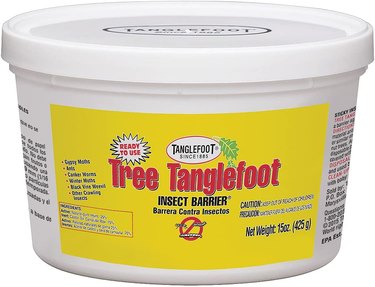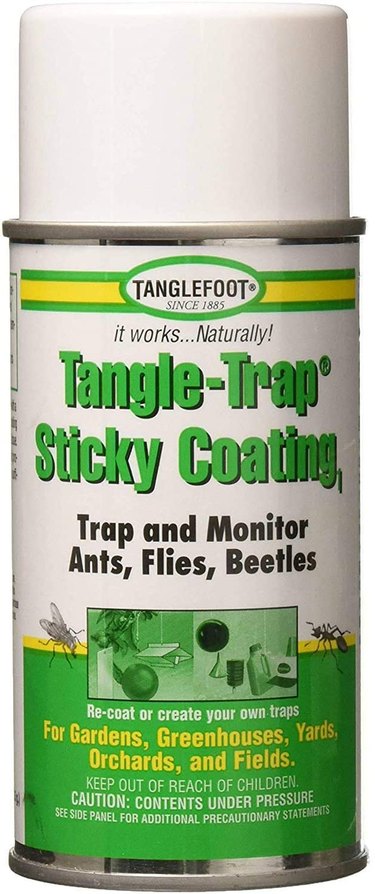Also called "snout beetles" because of a prominent protuberance called a proboscis, weevils and their larvae can be pervasive garden pests that potentially cause significant damage to certain plants. There are thousands of species of weevils that prey on different types of plants. For example, the same landscape that supports pecan trees, roses and strawberry plants may also have three or more different types of weevils, each of which is attracted to certain host plants.
To control weevils and their larvae in your yard and garden effectively without using synthetic chemical pesticides, it's important to be able to differentiate these pests from other insects. Organic control methods that work on other pests may not be effective on weevils and vice versa. Understanding the weevil's life cycle is also essential for knowing how to control these pests. By disrupting this life cycle, you'll be able to eliminate or at least mitigate the damage to your plants.
Video of the Day
Video of the Day
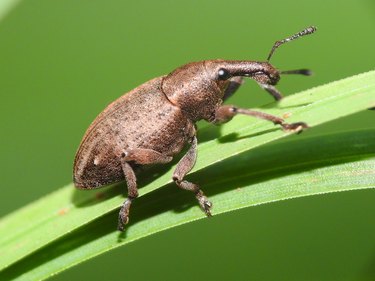
Weevil Identification and Morphology
Weevils (Curculionidae) belong to the order Coleoptera, which is the largest order in the class Insecta. As true insects, weevils share morphological characteristics with other insects, although the presence of a proboscis sets them apart from other insect species. The proboscis, which is a modified mouthpiece, may be short and broad or elongated, but you'll be able to identify it if you see one. Even though this snout may look a little menacing, weevils won't sting or bite you.
Adult weevils have hard bodies, segmented by a head, thorax and abdomen. Weevil sizes vary depending on species. For example, the strawberry weevil is approximately 1/4 inch long, and the palmetto weevil can reach a length of more than 1 inch. Some weevils have wings, which are hidden underneath protective coverings, and other types of weevils lack wings.
Typically dark-colored, some weevils also have colorful markings on their dark bodies that include shades of orange and lime-green. Weevil antennae are clubbed (with knobby ends) and elbowed (bent).
Weevil Life Cycle
Some weevil species, including the lilac root weevil, reproduce sexually by having separate male and female genders. Other species, including the strawberry root weevil and black vine weevil, reproduce asexually because they produce only females. Regardless of species and method of reproduction, adult weevils lay eggs, generally in late spring through summer, that hatch into grublike larvae. Some weevils lay their eggs on the surface of the soil or in leaf litter, and others lay their eggs inside plant parts, such as the pecan weevil that bores into pecans to lay its eggs there.
When the eggs hatch, the larvae begin feeding. For species that lay their eggs on the soil surface or in organic matter on top of the ground, the hatchling larvae burrow into the ground, where they feed on plant roots. When pecan weevil larvae hatch inside the hard shell of the nuts, they feed on the nutmeats inside. After the infested nuts fall from trees, the weevil burrows into the soil after burrowing through the nut's shell.
Weevil larvae pupate in the soil before emerging as adults, typically from early spring through late summer depending on the species. Some weevil species may spend only one winter season underground in the larval stage, while other species may spend two or three years underground before pupating and progressing to the adult stage.
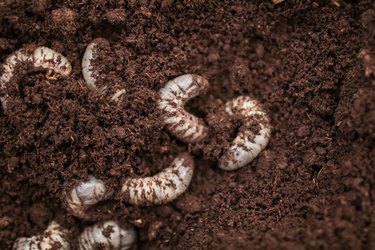
Weevil Plant Damage
An agricultural crop calamity in the early 1900s gave the word "weevil" instant recognition. Even today, the term "boll weevil" is recognizable by many people who many not even know exactly what a weevil is. Boll weevils caused catastrophic damage to plants and economic damage to planters because of the way these insects voraciously fed inside the cotton bolls, which prevented the fluffy cotton from being able to form.
Cotton bolls are the fruits of the cotton plant, which split open when mature to reveal the soft, fluffy cotton that surrounds the seeds. Similar to how boll weevils caused damage to the cotton plant, different weevil species also burrow into other types of fruit, flowers and roots to feed on these plant parts.
The diversity of plant species susceptible to boll weevil damage is staggering. Some adult weevils eat the leaves of certain trees, including maple, birch, willow and poplar. Other adult weevils eat the flowers and leaves of certain annuals and perennials, including roses and peonies, and many types of adult weevils prefer eating fruit and nuts. Weevil larvae feed on the roots and crowns of many types of plants, including turfgrass.
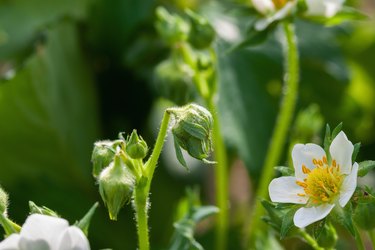
Weevil Control in the Garden
Controlling weevil populations in your yard and garden can be a daunting task, particularly because of this insect's multistage life cycle that may take several years to complete. Implementing a multipronged strategy that targets the larval as well as the adult stages of this insect yields better results than only going after the adults. If you eradicate the larvae, you'll prevent them from maturing into the adults that lay eggs and perpetuate the insect's life cycle.
Beneficial nematodes are microscopic worms that feed on weevil larvae (these are not parasitic nematodes that feed on plant roots). Different beneficial nematode species kill weevil larvae, but those in the Heterorhabditis genus (notably Heterorhabditis bacteriophora) are most effective. Mix Nature's Good Guys beneficial nematode powder in water according to the label directions to make a soil drench that you simply apply to the soil with a hose-end sprayer or watering can around infested plants. The timing of application for greatest impact is typically in summer after weevil eggs have hatched and the soil has warmed.
If you're having a problem with weevils that lay their eggs inside fruits and nuts, you can use a sticky insect barrier around your tree trunks. This works by trapping the adult weevils as they emerge from the soil after pupating, preventing them from climbing into trees and laying their eggs in fruits and nuts. After wrapping the included insect barrier band around your trees, apply Tree Tanglefoot® to the band with a putty knife. You can also make your own DIY barrier band and use Tanglefoot Tangle-Trap®, which is an aerosol spray that you use to apply the sticky coating to the band.
Product Recap:
- Pesticide-free biological weevil larvae control
- Nontoxic to people, plants and the environment
- Mix with water to make a soil drench around infested plants
- Sticky coating in a tub applied with a putty knife to the enclosed insect barrier band
- Ready to use
- Weatherproof
- OMRI rated for organic gardening
- Sticky coating in aerosol form
- Apply to your own DIY insect barrier band
- Reapply as needed

